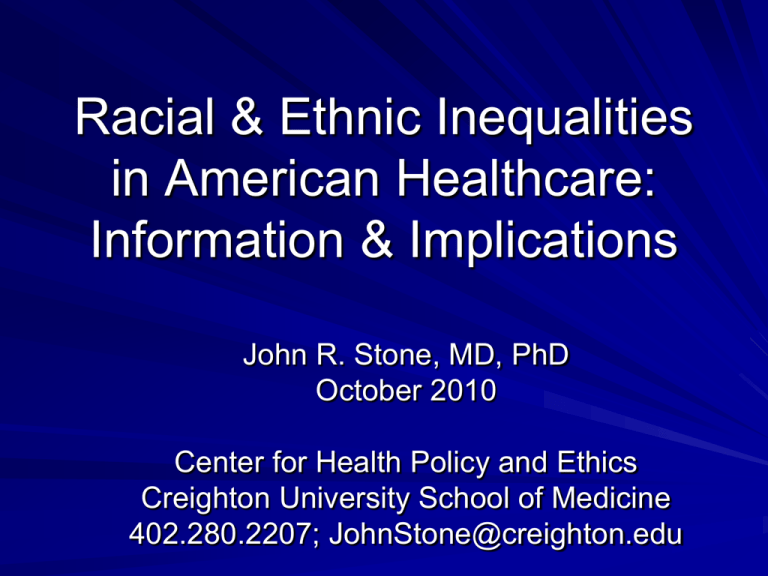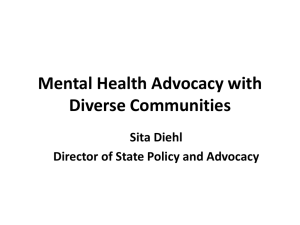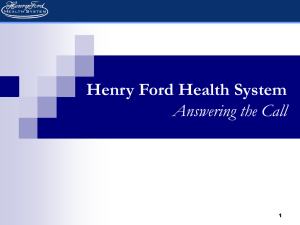
Racial & Ethnic Inequalities
in American Healthcare:
Information & Implications
John R. Stone, MD, PhD
October 2010
Center for Health Policy and Ethics
Creighton University School of Medicine
402.280.2207; JohnStone@creighton.edu
Learning Objectives
Summarize health & healthcare
inequalities
Explain professional & institutional
factors in unequal healthcare
Explain cross-cultural & other
strategies for promoting equal
healthcare.
Unequal Health & Healthcare
“Unnatural Causes”*
Racial/Ethnic minorities, Native Americans
Diseases
– Diabetes
– Infant mortality maternal health
– Cardiovascular (HPT, MI, CHF)
– Cerebrovascular (Stroke)
– Obesity
– Cancer
* http://www.unnaturalcauses.org/about_the_series.php (Accessed 11Oct2009)
Maternal
Health
Adult
Health
Fetal
Health
Stress
HPT
Diabetes
Stroke
Kidney Dis
Preterm birth
Low birth wt
Higher infant
mortality
Infant
Health
Childhood
Health
Adapted from: Gravlee CC. How race becomes biology: Embodiment of social
inequality. Am J Phys Anthropol. 2009; 139(1):47-57
Major Disparities Categories
Race/ethnicity
Socio-economic status
Gender
Mental health status
Age
Language
DeLancey JO, Thun MJ, Jemal A, Ward EM. Recent trends in black-white disparities in
cancer mortality. Cancer Epidemiol Biomarkers Prev. 2008; 17(11):2908-2912.
DeLancey JO, Thun MJ, Jemal A, Ward EM. Recent trends in black-white disparities in
cancer mortality. Cancer Epidemiol Biomarkers Prev. 2008; 17(11):2908-2912.
DeLancey JO, Thun MJ, Jemal A, Ward EM. Recent trends in black-white disparities in
cancer mortality. Cancer Epidemiol Biomarkers Prev. 2008; 17(11):2908-2912.
Health & Well-being
Social
Determinants
Healthcare
Health
9
*Powers M, Faden R. Social Justice: The Moral Foundations of Public
Health and Health Policy. New York: Oxford Univ. Press, 2006.
Ethics and Health/Healthcare
Inequalities
Sufficient Level of
Health for All*
Human
Flourishing/Well-being
10
*Powers M, Faden R. Social Justice: The Moral Foundations of Public
Health and Health Policy. New York: Oxford Univ. Press, 2006.
Causal Loci: Health
Upstream
Downstream
Healt
h
Healthcare Loci of Action
Globe
Nation
Region
Community
System
Clinic/ho
sp
Physicians’ Social Responsibilities
Physicians’ are individually and collectively
obligated to work toward elimination of
unjust root social inequalities that
adversely affect health.
Moral foundations: respect, justice, social
contract, reciprocity
See the argument.
Stone, Cambridge Quarterly of Healthcare Ethics, 2010
“I treat
everyone
equally.”
Unfair Treatment
Racial/ethnic Minorities
Is Rare or Never
White phys: 75%
Asian phys: 65%
Clark-Hitt 2010
Latino phys: 47%
AA phys: 22%
Why do studies demonstrate
healthcare inequalities/disparities?
Physicians’ Views
Flawed studies
Patients’ fault (AA,
Latino, ……)
–
–
–
–
–
Behavior
Compliance
Literacy
Attitude
Preference
Clark-Hitt 2010
System
Communication
Provider bias
“Social Patterning”
Patient-Doctor
Lower social class
– More directive, less participatory
Ethnic Minority
– less expression of empathy or rapport
Forde I, Raine R. Placing the individual within a social determinants approach
to health inequity. Lancet. 2008; 372(9650):1694-1696.
Colorectal Cancer Disparities
Colorectal cancer:
1975-2000: incidence
& mortality 22,26%
AA/W:
– Incidence 20%
– Death 50%
Flex Sig:
Polyps/masses ~ =
Ayanian, JNCI 2010
Colonoscopy
Adeonomas & cancer
~=
How to understand
the disparities?
Colorectal Disparities AA/W
Understanding
Biol unlikely explains
AA less colonoscopy
after flex sig (63/72%)
Poss explanations of
lower colonoscopy
rates
– Adjusted for age, sex,
education, BMI, other
primary care phys
community access
to gastroenterologists
– Poss insurance
– Out of pocket too
– (Preferences not a
major factor in
comparable studies)
Ayanian, JNCI 2010
Colorectal Disparities AA/W
Possible Remedies
Promising remedies
– Public education
– Navigators
– Tracking (better)
Community-based
programs
– Focus on
disadvantaged
Healthcare reform
(Ayanian omits)
Ayanian, JNCI 2010
Colorectal Disparities AA/W
Intervening
Collaboration
Leadership
Collaborative
leadership
Community partnering
Navigator/educators
Centers and
partnerships
Creighton University
Center for Promoting
Health and Health
Equality
CU Center for Promoting Health
and Health Equality (CPHHE)
A community-academic partnership
http://www.creighton.edu/health/cphhe/
An Intervention Example
Breast Cancer Disparities
A Systems Approach
Bickell NA, Cohen A.
Disparities in Breast Cancer Treatment.
Mt Sinai J Med 2008;75:23–30.
Quality Improvement
Acute Myocardial Infarction
Figure 1.
Racial and Ethnic Differences in the Treatment of Acute
Myocardial Infarction: Findings From the Get With The
Guidelines-Coronary Artery Disease Program.
Cohen, Mauricio; Fonarow, Gregg; Peterson, Eric; MD,
MPH; Moscucci, Mauro; MD, MBA; Dai, David;
Hernandez, Adrian; MD, MHS; Bonow, Robert; Smith,
Sidney
Circulation. 121(21):2294-2301, June 1, 2010.
DOI: 10.1161/CIRCULATIONAHA.109.922286
Figure 1. Temporal trends in the proportion of eligible
patients with door-to-thrombolysis times within 30
minutes and door-to-balloon times within 90 minutes
according to racial/ethnic groups. The trend for door-tothrombolytic time indicates no significant variation over
time; however, the proportion of patients with door-toballoon times within 90 minutes increased at a rate of 6%
per quarter. The trends were not significantly different
according to race/ethnicity. The odds ratio comparing
black and Hispanic to white patients also account for
trends over time. OR indicates odds ratio; AA, black
(African American); C, white (Caucasian); Hisp, Hispanic;
and q1, q2, q3, and q4, quarters 1 through 4,
respectively.
© 2010 American Heart Association, Inc. Published by American Heart Association.
2
Quality Improvement (QI) in
Acute Myocardial Infarction
Is QI the cause of racial/ethnic
inequalities in care?
– Unknown
Will QI improve racial/ethnic survival and
quality-of-life?
– Unknown
Cook 2010
Hospital Equity Reports: An “Action Step”
Aim: unequal care: race, ethnicity,
language, socio-economic status
Measures
– Distribution: where seen, what conditions
– Utilization & process
Do children receive advised # well-child visits?
How often & long are asthma patients in hospital?
Do qualified patients preventive screening tests?
Robin M.Weinick, Katherine Flaherty, and Steffanie J. Bristol. Creating Equity Reports:A Guide for
Hospitals.The Disparities Solutions Center, Massachusetts General Hospital, 2008.
http://www.massgeneral.org/disparitiessolutions/resources.html.
“The Case of LJ”
Story
LJ, 86, AA, HS Grad,
Pentecostal.
To hosp “under protest”
Foot melanoma 5 yrs
Infection, thrombosis….
Concealed from family
No stock in medical care
Refuses amputation
Children astonished
Children disagree
Med staff disagree w LJ
LJ “irascible”
Competence question
Psych: incompetent due
to religious delusion
“I’ve made up my mind to
die if that’s God’s will.”
Tia Powell. Religion, Race, and Reason: The Case of LJ. The Journal of Clinical Ethics.
1995, 6(1):73-77.
“The Case of LJ”
Issues-Powell
Religious beliefs
Anger, refusal
“Opinionated,”
“dominating”
Competency
AA, Woman, 86
Seen as “alien”…crazy
Issues-Dula
Autonomy v med profess
Info starved
Power & control
Need for cultural & relig
knowledge
Hospital as hostile
Race, gender, age
Tia Powell. Religion, Race, and Reason: The Case of LJ. The Journal of Clinical Ethics.
1995, 6(1):73-77.
Annette Dula. LJ’s Religious Craziness. The Journal of Clinical Ethics. 1995, 6(1):77-80.
Caring for LJ
Care about
Care for
Historical sensitivity
Racial/cultural understanding
Nexus of support: family, church, friends
Patience
Process
Acceptance of difference
Evolution of Cultural Competence
“Cultural competence is the ability of health care
professionals to communicate with and
effectively provide high-quality care to patients
from diverse sociocultural backgrounds; aspects
of diversity include—but go beyond—race,
ethnicity, gender, sexual orientation, religion,
and country of origin.”
Previous “categorical approach”: “attitudes,
values, beliefs, and behaviors of specific cultural
groups”
Betancourt 2010
Evolution of Cultural Competence
General community/cultural background is
helpful.
Learning sets of attributes stereotyping
and oversimplification.
Current model: skills and framework for
individual assessment: “what sociocultural
factors might affect that patient's care”
Betancourt 2010
Distrust
Guadagnolo BA, Cina K, Helbig P, et al.
Medical mistrust and less
satisfaction with health care
among Native Americans
presenting for cancer treatment. J
Health Care Poor Underserved. 2009;
20(1):210-226
Cross-cultural/Multi-cultural
Provider level
System level
Cross-cultural/Multi-cultural
System Level
Leadership role
Widespread and continued training for
cultural competency/proficiency/humility
Ongoing institutional journey
Promote trust through trustworthiness
Partner & collaborate with served
communities
Teaching about R/E Disparities
Learning Objectives
“Understand your own racial and cultural
background”
“Understand cultural diversity and the
relationship between racial and cultural attitudes
and quality of care”
“Understand U.S. racial and ethnic population
trends and the prevalence and severity of racial
and ethnic health disparities”
Smith WR et al. Recommendations for Teaching about Racial and Ethnic Disparities in Health and
Health Care. Annals of Internal Medicine. 2007;147(9):654-665
Teaching about R/E Disparities
Learning Objectives
“Identify several types and causes of racial
or ethnic health disparities”
“Understand the community in which you
practice”
“Know how to conduct cross-cultural and
cross-language clinical encounters”
Smith WR et al. Recommendations for Teaching about Racial and Ethnic Disparities in Health and
Health Care. Annals of Internal Medicine. 2007;147(9):654-665
Teaching about R/E Disparities
Learning Objectives
“Use a patient-centered approach to clinical
encounters”
“Negotiate conflict resulting from differences
between patient explanatory models of illness
and treatment and physician models”
“Learn and apply skills to combat racial, ethnic,
and cultural barriers to effective care” [Add:
language barriers]
Smith WR et al. Recommendations for Teaching about Racial and Ethnic Disparities in Health and
Health Care. Annals of Internal Medicine. 2007;147(9):654-665
“I treat
everyone
equally.”
Eliminating Inequalities: Structures
Measure outcomes
Require publishing outcomes
Assess structures
Include communities: all levels and roles
Change structures
Implement & evaluate strategies
Nicole Lurie. Health Disparities — Less Talk, More Action.
NEJM 2005; 353:727-729
Healthcare Equity
Robin M.Weinick, Katherine Flaherty, and Steffanie J. Bristol.
Creating Equity Reports: A Guide for Hospitals. The
Disparities Solutions Center, Massachusetts General
Hospital, 2008. The model and many related documents and
information is available at
http://www2.massgeneral.org/disparitiessolutions/resources.ht
ml. At that site see:
Resources Produced by the Disparities Solutions Center
Improving Quality and Achieving Equity: A Guide for Hospital
Leaders
Assuring HealthCare Quality: A Healthcare Equity Blueprint
Creating Equity Reports: A Guide for Hospitals
Health/Healthcare Inequalities
& Culture
Adler NE, Stewart J. Health disparities across the lifespan: Meaning, methods, and
mechanisms. Ann N Y Acad Sci. 2010; 1186:5-23.
Ashing-Giwa KT, Gonzalez P, Lim JW, et al. Diagnostic and therapeutic delays
among a multiethnic sample of breast and cervical cancer survivors. Cancer. 2010;
116(13):3195-3204.
Ayanian JZ. Racial disparities in outcomes of colorectal cancer screening: Biology or
barriers to optimal care? J Natl Cancer Inst. 2010; 102(8):511-513.
Betancourt JR, Green AR. Commentary: Linking cultural competence training to
improved health outcomes: Perspectives from the field. Acad Med. 2010; 85(4):583585.
Tervalon M, Murray-Garcia J. Cultural humility versus cultural competence: A critical
distinction in defining physician training outcomes in multiculural education. J of
Health Care for the Poor and Underserved. 1998; 9(2):117-125.
Healthcare Inequalities
Clark-Hitt R, Malat J, Burgess D, Friedemann-Sanchez G. Doctors' and nurses'
explanations for racial disparities in medical treatment. J Health Care Poor
Underserved. 2010; 21(1):386-400.
Cohen MG, Fonarow GC, Peterson ED, et al. Racial and ethnic differences in the
treatment of acute myocardial infarction: Findings from the get with the guidelinescoronary artery disease program. Circulation. 2010; 121(21):2294-2301.
Cook NL. Disparities in cardiovascular care: Does a rising tide lift all boats?
Circulation. 2010; 121(21):2253-2254.
Peterson E, Yancy CW. Eliminating racial and ethnic disparities in cardiac care. N
Engl J Med. 2009; 360(12):1172-1174.
Ethics & Health/Healthcare
Inequalities
Stone JR. Saving and Ignoring Lives: Physicians’ Obligations to Address
Root Social Influences on Health—Moral Justifications and Educational
Implications. Cambridge Quarterly of Healthcare Ethics. 2010;19:497–509
Stone JR and Dula A. “Race/Ethnicity, Trust, and Health Disparities:
Trustworthiness, Ethics, and Action.” Book chapter, Cultural Proficiency in
Addressing Health Disparities. Editors: Kosoko-Lasaki S, Cook CT, O'Brien
RL. Sudbury, MA: Jones & Bartlett, 2008, pp. 37-56.
Stone JR. Healthcare inequality, cross-cultural training, and bioethics:
Principles and applications. Camb Q Healthc Ethics. 2008; 17(2):216-226.
Dula A, Stone JR. Wakeup call: Healthcare and racism. Hastings Center
Report, ;. 2002; 32(4):48
Stone J. Race and healthcare disparities: Overcoming vulnerability. Theor
Med Bioeth. 2002; 23(6):499-518.









